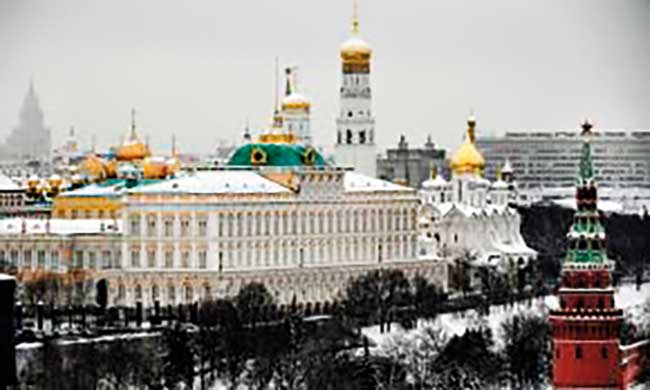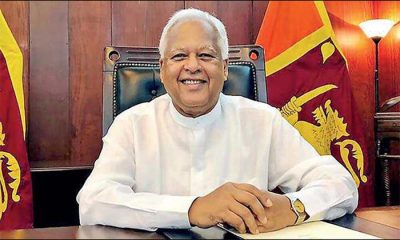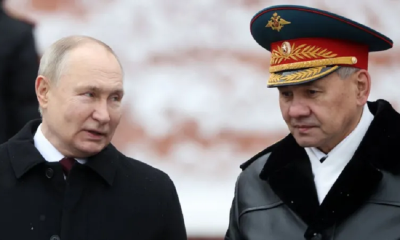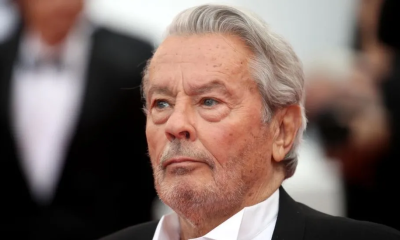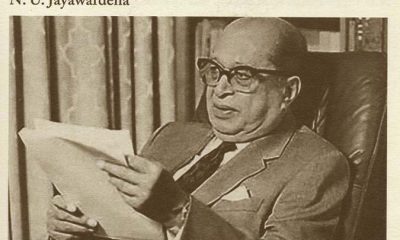Features
Traveling in Russia for UNESCO and more of life in Paris

(Excerpted from volume ii of the Sarath Amunugama autobiography)
In the final years of the gerontocracy that ruled the Communist Party and the USSR we received the green light to have the annual general meeting of the Internatioal Programme for the Development of Communications (IPDC) in the Soviet Union. This was a special plus for the IPDC because till now its main backers were the Third World countries and the Nordic group. The Soviet delegation which included the general manager of Tass News Agency as well as Zassousky of Moscow University and several top brass from the Foreign Ministry managed to convince the old men in the Kremlin that it was in their interest to ally with the many Third World countries associated with UNESCO and IPDC.
As if to reinforce their Third world connections it was suggested that the meeting be held in Tashkent – the capital of Socialist Uzbekistan. The USSR had already built up Tashkent as their window to Asia. For instance, the Tashkent Film Festival was well known in Asia and Africa. The city had the infrastructure to mount a global conference. Preparatory work for the meeting was assigned to me and my office. My counterpart was Sasha, an official in the USSR Embassy in Paris, who was charged with UNESCO relations.
We struck up an instant friendship as we had to travel many times to Moscow together to finalize arrangements for the meeting. Since it was a high level UN conference M’Bow himself would attend it. Having received a battering from the western press the DG looked forward to the choreographed welcome he was bound to receive in the USSR. This was a difficult time for him since the spat with the USA had led to him being demonized in the Western media.
He discovered too late that it was not possible to win over the western media if you take on the Jewish lobby. Once the press begins to demonize you, it becomes difficult even for political leaders to help you. M’Bow was beginning to go down the slippery slope and he found that the popularity of the IPDC among all political camps gave him a chance to mend fences. But the Reagan administration did not approve of him on the Israeli issue.
The US left UNESCO, which created a gaping hole in our budget. Japan came to the rescue by increasing its contribution. But there was a price tag to the rescue act. It began to suggest changes at the top and very soon M’Bow was replaced by a Japanese Secretary General.
While preparations for the Tashkent meeting brought me to Moscow many times, I also had to negotiate some tricky points with the Communist Party bureaucrats. One such issue was regarding visas. Any UN meeting presupposes the issuing of visas to all participants recommended by it. The host country cannot impose any conditions regarding the travel and security of the participants once they are within its borders.
All arrangements for board and lodging of participants must be approved by us. All this had to be handled sensitively as the US had added several anti-Communist hardliners to their observer delegation perhaps hoping to sow confusion. In all probability these delegates would not have been issued visas if they had applied directly to Moscow. Among these hardliners or ‘cold war warriors’ was Alan Weinstein, a University Professor who had published a lengthy volume presenting evidence to prove his thesis that the killing of John F Kennedy was the act of a ‘lone assassin’ and was not a conspiracy.
Weinstein was considered to be a USSR watcher for Reagan. He was joined in the journey to Tashkent by an alcoholic Californian journalist Nossiter who was a favourite of the US President. It looked very much as though the US delegation was expecting some mishap which could be highlighted at home in their ongoing effort to vilify the United Nations. So we had to be extra careful in our preliminary arrangements.
While in Moscow I took time off for sightseeing. The city was full of old dynastic buildings. The multi-coloured churches with their onion like domes were an architectural wonder. The massive Red Square in the Kremlin with a lit up lone red star looking down from the highest building was an inspiring sight to me, who as an undergraduate at Peradeniya, had pored over books written about the historic Red revolution of the Bolsheviks led by Lenin.
To my pleasant surprise my guide to the historic sites of the city was Ordzhonikidze – the great grandson of a fellow Georgian revolutionary and comrade of Stalin. The original Sergo Ordzhonikidze was one of the heroes of the revolution. He was rare among the early leaders to die unscathed by the terror launched by Stalin. Stalin named one of his battle ships after him. However the latest research has thrown doubt about the manner of his death.
My guide was a young man well versed in the history of the revolution. He took me to the Museum of the Revolution which narrates the history of that epochal event. Communists have no hesitation in rewriting history to fit their current preoccupations. For example in all the old photos of revolutionary leaders, Trotsky had been air brushed out. Since I was familiar with the original photos from Isaac Deutscher’s books I asked my guide about it.
His answer shocked me. He told me that he had not even heard of such a name. He added that none in his generation knew of Trotsky. We then visited the Lenin Mausoleum to view Lenin’s embalmed body which a writer has described as a ‘communist relic’. By this time Khrushchev had ensured that Stalin’s sarcophagus which had lain side by side with Lenin’s was removed from the viewing hall. The Russians are obsessed with sarcophagi.
In the basements of the old churches with onion domes – of the Russian Orthodox Church – in ancient boxes lie the remains of church leaders of the past years. The communists have buried the remains of ancient kings but have left the churchmen alone in the crypts. I remembered that Moscow is only a part of the story. The revolution took place in St Petersburg with its Winter Palace.
Much later, on an official visit there with President Mahinda Rajapaksa I was able to imagine the drama at the beginning of the Russian Revolution. The ship ‘Aurora’ which figures largely in history because the sailors mutinied and threatened to bombard Petersburg in support of the revolutionaries was, we saw, moored in Petersburg harbour. But Moscow became the new capital. Ordinokidze and I motored to the outskirts of Moscow to see last ditch defences Stalin had set up to prevent Hitler’s tanks rolling down to take the beleaguered capital which housed Stalin and the Central Committees.
Soviet Tanks and soldiers had made a heroic stand there and driven back the Nazis. After the guided tour we lunched at Moscow’s famous five star restaurant `Matryoshka’ on Katuzovsky Avenue, which was a popular meeting place of the Moscow elite. I went back to my Hotel Moskva and got ready for the highlight of my tour, the visit to the Bolshoi Theatre to see ‘Swan Lake’ danced by the world famous Bolshoi Ballet. I had seen ‘Swan Lake’ in Paris, Berlin [called ‘Schwansee’ in German] and London but the Bolshoi version was the most breathtaking, both for the dancing and Tchaikovsky’s music.
After this encounter I was ready to fly back to Paris. My friend Sasha of the Paris embassy then introduced me to a touching traditional Russian gesture. He brought a home cooked loaf of bread wrapped in a bandana. His wife, who was a teacher of English in a University, had baked the bread. In the past in Russia when a family member or friend undertook a long journey his loved ones would cook him a loaf of bread, wrap it and hand it over so that he would not go hungry. I too was given that touching honour and was greatly moved.
Promising to come back, I took the Air France flight back to Paris and home after a wonderful experience in Soviet Russia. By a coincidence seated next to me on the flight was Bala Tampoe who was one of my heroes from University days. We talked and on the following day I took him out to lunch in a posh hotel close to the ‘Le Monde’ office where Bala had an interview with a French journalist.
Tashkent
The Tashkent meeting was quite a victory for the newly formed IPDC. The international situation was moving towards dialogue and nations were looking for signals, however small they may appear at first, of a thaw in the Cold War. The USSR was in a state of paralysis after a period of rule by geriatric leaders. Gorbachev was in the wings and soon ‘Perestroika’ and ‘Glasnost’ was to emerge to shake up the Communist world.
As mentioned earlier Ronald Reagan sent a delegation of right wing hardliners to Tashkent. They were carefully handled by the State Department officials who came along with them from Washington. They came expecting a frosty reception but the USSR and our staff made sure that they felt comfortable as they were invited to many meals, and especially drinking sessions, in the best Tashkent restaurants. According to American Foreign service officers, their report to Reagan was conciliatory.
Sensing the value of this meeting M’Bow himself attended the conference. He was treated with great respect by the USSR authorities, which was a contrast to the way in which he had been treated by a visiting US under-secretary. At the meeting, defying expectations of a boycott, western delegates who provided most of the funds, were happy that IPDC was short on rhetoric but had successfully collected funds and launched many projects to improve communications facilities in the poorer nations.
The USSR also by selecting Tashkent had signaled that they were on the side of the developing nations. Tashkent was their gateway to Asia and the “third world” countries. They had invested heavily in providing hotels and conference centres in the city. Though we were put up in the best hotel we got a shock when an earthquake hit Tashkent and we had to run out to the open in the night till the tremors subsided. It was a comic sight to see the distinguished delegates congregating on the lawn in their night clothes. Later we were assured that such tremors were not exceptional and the hotel was built to be earthquake proof I doubt whether our seasoned diplomats bought that story in its entirety.
Samarkand
After the grand finale of the meeting USSR authorities had arranged an excursion to Samarkand for the participants. Samarkand has been described by a poet as “a rose red city half as old as time”. It had been the cradle of the Mughal, which later became a famous centre of Islamic learning. We saw one of the oldest Universities of the world with its warren like rooms for the young scholars who then traversed Asia and the Middle East propagating the Islamic faith.
They were also the early scientists and astronomers who advanced learning in mathematics and tracking of changes in the sky and stars. The world’s oldest telescope to observe the skies was located in Samarkand. The Tashkent meeting brought me even closer to the Asian delegates to UNESCO and IPDC. Among them was G. Parthasarathy, the head of the Indian delegation. GP was close to the Nehru family having been the PMs roving ambassador. He was India’s Ambassador to Vietnam at a crucial time when Nehru was called upon to be a mediator in the growing political crisis in that country. We became close friends with consequences that I will describe later in this chapter.
The UNESCO top brass was pleased with our management of the conference. M’Bow held a reception for the staff and thanked them. When the inevitable cuts foIlowing the US withdrawal came, IPDC was not touched. We were encouraged to keep up our ties with the State Department Officials in Paris who were themselves unhappy about the withdrawal but could do nothing about it. They assured us that eventually the US will return and that is what really happened later. In the meanwhile, USAID with whom we had excellent relations continued several of our projects bilaterally with those countries concerned.
Rue Jean Daudin
As stated earlier with the arrival of my family in Paris I moved to a spacious flat in Rue Jean Daudin which was close to UNESCO headquarters and my office in Rue Miollis. This was a posh quartier in Paris being close to the Eiffel Tower, Trocadero, the Ecole Militaire and Champ de Mars – the most famous park in Paris. The shift of residence from a ‘Red’ working class district to the heart of upper class Paris gave me an opportunity of experiencing different historical cultures of that ancient city.
The topography of Paris is highly segmented on the basis of social class. As a jogger in my new locality I could run past the military school which had produced a Napoleon as well as all the military leaders of World wars including De Gaulle. In fact paratroop commanders led by Generals Salan and Massu, who opposed De Gaulle’s change of policy on Algeria, attempted to assassinate him in front of the Ecole Militaire. This real event forms the backdrop of the famous thriller ‘Day of the Jackal’ which became a bestseller.
I ran past the Invalides – a hospital for war veterans established by Napoleon, which is now a war museum. From there I would reach the Champs de Mars and the Tour Eiffel. Then I would go past the Trocadero, down the steps near the Musee de Homme and back to my home in Rue Jean Daudin. It was a daily chore which not many people would have had the privilege of enjoying. But it was also saddening because my route was dotted with plaques commemorating the resistance fighters who had been put against the wall in those locations and summarily executed by the Gestapo during the Nazi occupation. From time to time old ladies – relatives, girlfriends and surviving comrades-would hobble up to those monuments to lay a bunch of flowers as remembrance of those sad times past.
I then got down to the task of finding schools for my two daughters who were delighted to be in Paris at the best time of their young lives. Ramanika who was 18 enrolled in the American University of Paris while Varuni who was 15 joined the British school of Paris which was located out of the city in idyllic surroundings. The British school bus was parked at the Trocadero and the students, who were mostly from the posh quartiers, had to come there by car or metro.
Varuni would take the Segur Metro to Trocadero first with her mother but soon on her own, and catch the school bus to the suburbs with her mischievous schoolmates who were mostly drawn from UNESCO and embassy families. Occasionally my wife and I visited the school to inquire about Varuni’s progress. We were accompanied by Navaz as an interpreter and two other Sri Lankans. The school management would have been horrified to see a delegation of Asians descending on their school, all intent on following the early baby steps in education of their new entrant Varuni Amunugama.
But both children adapted themselves well and would merge easily with their new friends who were up to their usual pranks in class and on school tours to England, Ireland and parts of Europe. They were both on great demand as ‘baby sitters’ to small children of the super-rich like Bank Directors, Ambassadors and Supermodels who paid them handsomely. With the money so collected the two girls traveled through Europe by train on their own.
In Geneva they were looked after by Jayantha and Maureen Dhanapala. In Rome they stayed with Mahinda Ranaweera and his wife who were UNESCO functionaries there. In Germany they were guests of my wife’s cousin who was married to an embassy official in Bad Godesberg. They were popular ‘baby sitters’ because they spent part of their allowance buying chocolates for their wards.
We also had many Sri Lankan friends staying with us. Namel and Malini Weeramuni, our friends from way back, toured France with some companions in a caravan and I arranged a flat nearby for them to stay while visiting Paris. Lester and Sumitra Peries were regular visitors to Paris. Earlier their good friend Vernon Mendis, who was our Ambassador, had entertained them. They also had friends in the French film industry, some of whom were associated with the Cannes Film Festival.
Sumitra’s film `Loku Duwa’ produced and acted by Geetha Kumarasinghe was selected under a special section in Cannes called ‘Un Certain Regard’ which was a considerable achievement for both Sumitra and Geetha. A lot of work went into making a shorter version of the Sinhala film, subtitling, striking extra prints and launching of a publicity drive in the French media. All this was done and `Loku Duwa’ was screened to an enthusiastic audience.
On another occasion Sumitra visited Paris and stayed with us when one of her films was presented at the Nantes Film Festival. Richard Ross and his wife Jane who were our close friends when they were in Colombo as attaches to the US Embassy, were in Paris serving in the US embassy. They were living on a houseboat moored on the river Seine. Dick and Jane invited us for dinner on their boat. It was a fun party with plenty of drinks and as the music increased in tempo, we were scared that an inebriated guest would jump into the river.
Features
The heart-friendly health minister

by Dr Gotabhya Ranasinghe
Senior Consultant Cardiologist
National Hospital Sri Lanka
When we sought a meeting with Hon Dr. Ramesh Pathirana, Minister of Health, he graciously cleared his busy schedule to accommodate us. Renowned for his attentive listening and deep understanding, Minister Pathirana is dedicated to advancing the health sector. His openness and transparency exemplify the qualities of an exemplary politician and minister.
Dr. Palitha Mahipala, the current Health Secretary, demonstrates both commendable enthusiasm and unwavering support. This combination of attributes makes him a highly compatible colleague for the esteemed Minister of Health.
Our discussion centered on a project that has been in the works for the past 30 years, one that no other minister had managed to advance.
Minister Pathirana, however, recognized the project’s significance and its potential to revolutionize care for heart patients.
The project involves the construction of a state-of-the-art facility at the premises of the National Hospital Colombo. The project’s location within the premises of the National Hospital underscores its importance and relevance to the healthcare infrastructure of the nation.
This facility will include a cardiology building and a tertiary care center, equipped with the latest technology to handle and treat all types of heart-related conditions and surgeries.
Securing funding was a major milestone for this initiative. Minister Pathirana successfully obtained approval for a $40 billion loan from the Asian Development Bank. With the funding in place, the foundation stone is scheduled to be laid in September this year, and construction will begin in January 2025.
This project guarantees a consistent and uninterrupted supply of stents and related medications for heart patients. As a result, patients will have timely access to essential medical supplies during their treatment and recovery. By securing these critical resources, the project aims to enhance patient outcomes, minimize treatment delays, and maintain the highest standards of cardiac care.
Upon its fruition, this monumental building will serve as a beacon of hope and healing, symbolizing the unwavering dedication to improving patient outcomes and fostering a healthier society.We anticipate a future marked by significant progress and positive outcomes in Sri Lanka’s cardiovascular treatment landscape within the foreseeable timeframe.
Features
A LOVING TRIBUTE TO JESUIT FR. ALOYSIUS PIERIS ON HIS 90th BIRTHDAY

by Fr. Emmanuel Fernando, OMI
Jesuit Fr. Aloysius Pieris (affectionately called Fr. Aloy) celebrated his 90th birthday on April 9, 2024 and I, as the editor of our Oblate Journal, THE MISSIONARY OBLATE had gone to press by that time. Immediately I decided to publish an article, appreciating the untiring selfless services he continues to offer for inter-Faith dialogue, the renewal of the Catholic Church, his concern for the poor and the suffering Sri Lankan masses and to me, the present writer.
It was in 1988, when I was appointed Director of the Oblate Scholastics at Ampitiya by the then Oblate Provincial Fr. Anselm Silva, that I came to know Fr. Aloy more closely. Knowing well his expertise in matters spiritual, theological, Indological and pastoral, and with the collaborative spirit of my companion-formators, our Oblate Scholastics were sent to Tulana, the Research and Encounter Centre, Kelaniya, of which he is the Founder-Director, for ‘exposure-programmes’ on matters spiritual, biblical, theological and pastoral. Some of these dimensions according to my view and that of my companion-formators, were not available at the National Seminary, Ampitiya.
Ever since that time, our Oblate formators/ accompaniers at the Oblate Scholasticate, Ampitiya , have continued to send our Oblate Scholastics to Tulana Centre for deepening their insights and convictions regarding matters needed to serve the people in today’s context. Fr. Aloy also had tried very enthusiastically with the Oblate team headed by Frs. Oswald Firth and Clement Waidyasekara to begin a Theologate, directed by the Religious Congregations in Sri Lanka, for the contextual formation/ accompaniment of their members. It should very well be a desired goal of the Leaders / Provincials of the Religious Congregations.
Besides being a formator/accompanier at the Oblate Scholasticate, I was entrusted also with the task of editing and publishing our Oblate journal, ‘The Missionary Oblate’. To maintain the quality of the journal I continue to depend on Fr. Aloy for his thought-provoking and stimulating articles on Biblical Spirituality, Biblical Theology and Ecclesiology. I am very grateful to him for his generous assistance. Of late, his writings on renewal of the Church, initiated by Pope St. John XX111 and continued by Pope Francis through the Synodal path, published in our Oblate journal, enable our readers to focus their attention also on the needed renewal in the Catholic Church in Sri Lanka. Fr. Aloy appreciated very much the Synodal path adopted by the Jesuit Pope Francis for the renewal of the Church, rooted very much on prayerful discernment. In my Religious and presbyteral life, Fr.Aloy continues to be my spiritual animator / guide and ongoing formator / acccompanier.
Fr. Aloysius Pieris, BA Hons (Lond), LPh (SHC, India), STL (PFT, Naples), PhD (SLU/VC), ThD (Tilburg), D.Ltt (KU), has been one of the eminent Asian theologians well recognized internationally and one who has lectured and held visiting chairs in many universities both in the West and in the East. Many members of Religious Congregations from Asian countries have benefited from his lectures and guidance in the East Asian Pastoral Institute (EAPI) in Manila, Philippines. He had been a Theologian consulted by the Federation of Asian Bishops’ Conferences for many years. During his professorship at the Gregorian University in Rome, he was called to be a member of a special group of advisers on other religions consulted by Pope Paul VI.
Fr. Aloy is the author of more than 30 books and well over 500 Research Papers. Some of his books and articles have been translated and published in several countries. Among those books, one can find the following: 1) The Genesis of an Asian Theology of Liberation (An Autobiographical Excursus on the Art of Theologising in Asia, 2) An Asian Theology of Liberation, 3) Providential Timeliness of Vatican 11 (a long-overdue halt to a scandalous millennium, 4) Give Vatican 11 a chance, 5) Leadership in the Church, 6) Relishing our faith in working for justice (Themes for study and discussion), 7) A Message meant mainly, not exclusively for Jesuits (Background information necessary for helping Francis renew the Church), 8) Lent in Lanka (Reflections and Resolutions, 9) Love meets wisdom (A Christian Experience of Buddhism, 10) Fire and Water 11) God’s Reign for God’s poor, 12) Our Unhiddden Agenda (How we Jesuits work, pray and form our men). He is also the Editor of two journals, Vagdevi, Journal of Religious Reflection and Dialogue, New Series.
Fr. Aloy has a BA in Pali and Sanskrit from the University of London and a Ph.D in Buddhist Philosophy from the University of Sri Lankan, Vidyodaya Campus. On Nov. 23, 2019, he was awarded the prestigious honorary Doctorate of Literature (D.Litt) by the Chancellor of the University of Kelaniya, the Most Venerable Welamitiyawe Dharmakirthi Sri Kusala Dhamma Thera.
Fr. Aloy continues to be a promoter of Gospel values and virtues. Justice as a constitutive dimension of love and social concern for the downtrodden masses are very much noted in his life and work. He had very much appreciated the commitment of the late Fr. Joseph (Joe) Fernando, the National Director of the Social and Economic Centre (SEDEC) for the poor.
In Sri Lanka, a few religious Congregations – the Good Shepherd Sisters, the Christian Brothers, the Marist Brothers and the Oblates – have invited him to animate their members especially during their Provincial Congresses, Chapters and International Conferences. The mainline Christian Churches also have sought his advice and followed his seminars. I, for one, regret very much, that the Sri Lankan authorities of the Catholic Church –today’s Hierarchy—- have not sought Fr.
Aloy’s expertise for the renewal of the Catholic Church in Sri Lanka and thus have not benefited from the immense store of wisdom and insight that he can offer to our local Church while the Sri Lankan bishops who governed the Catholic church in the immediate aftermath of the Second Vatican Council (Edmund Fernando OMI, Anthony de Saram, Leo Nanayakkara OSB, Frank Marcus Fernando, Paul Perera,) visited him and consulted him on many matters. Among the Tamil Bishops, Bishop Rayappu Joseph was keeping close contact with him and Bishop J. Deogupillai hosted him and his team visiting him after the horrible Black July massacre of Tamils.
Features
A fairy tale, success or debacle

Sri Lanka-Singapore Free Trade Agreement
By Gomi Senadhira
senadhiragomi@gmail.com
“You might tell fairy tales, but the progress of a country cannot be achieved through such narratives. A country cannot be developed by making false promises. The country moved backward because of the electoral promises made by political parties throughout time. We have witnessed that the ultimate result of this is the country becoming bankrupt. Unfortunately, many segments of the population have not come to realize this yet.” – President Ranil Wickremesinghe, 2024 Budget speech
Any Sri Lankan would agree with the above words of President Wickremesinghe on the false promises our politicians and officials make and the fairy tales they narrate which bankrupted this country. So, to understand this, let’s look at one such fairy tale with lots of false promises; Ranil Wickremesinghe’s greatest achievement in the area of international trade and investment promotion during the Yahapalana period, Sri Lanka-Singapore Free Trade Agreement (SLSFTA).
It is appropriate and timely to do it now as Finance Minister Wickremesinghe has just presented to parliament a bill on the National Policy on Economic Transformation which includes the establishment of an Office for International Trade and the Sri Lanka Institute of Economics and International Trade.
Was SLSFTA a “Cleverly negotiated Free Trade Agreement” as stated by the (former) Minister of Development Strategies and International Trade Malik Samarawickrama during the Parliamentary Debate on the SLSFTA in July 2018, or a colossal blunder covered up with lies, false promises, and fairy tales? After SLSFTA was signed there were a number of fairy tales published on this agreement by the Ministry of Development Strategies and International, Institute of Policy Studies, and others.
However, for this article, I would like to limit my comments to the speech by Minister Samarawickrama during the Parliamentary Debate, and the two most important areas in the agreement which were covered up with lies, fairy tales, and false promises, namely: revenue loss for Sri Lanka and Investment from Singapore. On the other important area, “Waste products dumping” I do not want to comment here as I have written extensively on the issue.
1. The revenue loss
During the Parliamentary Debate in July 2018, Minister Samarawickrama stated “…. let me reiterate that this FTA with Singapore has been very cleverly negotiated by us…. The liberalisation programme under this FTA has been carefully designed to have the least impact on domestic industry and revenue collection. We have included all revenue sensitive items in the negative list of items which will not be subject to removal of tariff. Therefore, 97.8% revenue from Customs duty is protected. Our tariff liberalisation will take place over a period of 12-15 years! In fact, the revenue earned through tariffs on goods imported from Singapore last year was Rs. 35 billion.
The revenue loss for over the next 15 years due to the FTA is only Rs. 733 million– which when annualised, on average, is just Rs. 51 million. That is just 0.14% per year! So anyone who claims the Singapore FTA causes revenue loss to the Government cannot do basic arithmetic! Mr. Speaker, in conclusion, I call on my fellow members of this House – don’t mislead the public with baseless criticism that is not grounded in facts. Don’t look at petty politics and use these issues for your own political survival.”
I was surprised to read the minister’s speech because an article published in January 2018 in “The Straits Times“, based on information released by the Singaporean Negotiators stated, “…. With the FTA, tariff savings for Singapore exports are estimated to hit $10 million annually“.
As the annual tariff savings (that is the revenue loss for Sri Lanka) calculated by the Singaporean Negotiators, Singaporean $ 10 million (Sri Lankan rupees 1,200 million in 2018) was way above the rupees’ 733 million revenue loss for 15 years estimated by the Sri Lankan negotiators, it was clear to any observer that one of the parties to the agreement had not done the basic arithmetic!
Six years later, according to a report published by “The Morning” newspaper, speaking at the Committee on Public Finance (COPF) on 7th May 2024, Mr Samarawickrama’s chief trade negotiator K.J. Weerasinghehad had admitted “…. that forecasted revenue loss for the Government of Sri Lanka through the Singapore FTA is Rs. 450 million in 2023 and Rs. 1.3 billion in 2024.”
If these numbers are correct, as tariff liberalisation under the SLSFTA has just started, we will pass Rs 2 billion very soon. Then, the question is how Sri Lanka’s trade negotiators made such a colossal blunder. Didn’t they do their basic arithmetic? If they didn’t know how to do basic arithmetic they should have at least done their basic readings. For example, the headline of the article published in The Straits Times in January 2018 was “Singapore, Sri Lanka sign FTA, annual savings of $10m expected”.
Anyway, as Sri Lanka’s chief negotiator reiterated at the COPF meeting that “…. since 99% of the tariffs in Singapore have zero rates of duty, Sri Lanka has agreed on 80% tariff liberalisation over a period of 15 years while expecting Singapore investments to address the imbalance in trade,” let’s turn towards investment.
Investment from Singapore
In July 2018, speaking during the Parliamentary Debate on the FTA this is what Minister Malik Samarawickrama stated on investment from Singapore, “Already, thanks to this FTA, in just the past two-and-a-half months since the agreement came into effect we have received a proposal from Singapore for investment amounting to $ 14.8 billion in an oil refinery for export of petroleum products. In addition, we have proposals for a steel manufacturing plant for exports ($ 1 billion investment), flour milling plant ($ 50 million), sugar refinery ($ 200 million). This adds up to more than $ 16.05 billion in the pipeline on these projects alone.
And all of these projects will create thousands of more jobs for our people. In principle approval has already been granted by the BOI and the investors are awaiting the release of land the environmental approvals to commence the project.
I request the Opposition and those with vested interests to change their narrow-minded thinking and join us to develop our country. We must always look at what is best for the whole community, not just the few who may oppose. We owe it to our people to courageously take decisions that will change their lives for the better.”
According to the media report I quoted earlier, speaking at the Committee on Public Finance (COPF) Chief Negotiator Weerasinghe has admitted that Sri Lanka was not happy with overall Singapore investments that have come in the past few years in return for the trade liberalisation under the Singapore-Sri Lanka Free Trade Agreement. He has added that between 2021 and 2023 the total investment from Singapore had been around $162 million!
What happened to those projects worth $16 billion negotiated, thanks to the SLSFTA, in just the two-and-a-half months after the agreement came into effect and approved by the BOI? I do not know about the steel manufacturing plant for exports ($ 1 billion investment), flour milling plant ($ 50 million) and sugar refinery ($ 200 million).
However, story of the multibillion-dollar investment in the Petroleum Refinery unfolded in a manner that would qualify it as the best fairy tale with false promises presented by our politicians and the officials, prior to 2019 elections.
Though many Sri Lankans got to know, through the media which repeatedly highlighted a plethora of issues surrounding the project and the questionable credentials of the Singaporean investor, the construction work on the Mirrijiwela Oil Refinery along with the cement factory began on the24th of March 2019 with a bang and Minister Ranil Wickremesinghe and his ministers along with the foreign and local dignitaries laid the foundation stones.
That was few months before the 2019 Presidential elections. Inaugurating the construction work Prime Minister Ranil Wickremesinghe said the projects will create thousands of job opportunities in the area and surrounding districts.
The oil refinery, which was to be built over 200 acres of land, with the capacity to refine 200,000 barrels of crude oil per day, was to generate US$7 billion of exports and create 1,500 direct and 3,000 indirect jobs. The construction of the refinery was to be completed in 44 months. Four years later, in August 2023 the Cabinet of Ministers approved the proposal presented by President Ranil Wickremesinghe to cancel the agreement with the investors of the refinery as the project has not been implemented! Can they explain to the country how much money was wasted to produce that fairy tale?
It is obvious that the President, ministers, and officials had made huge blunders and had deliberately misled the public and the parliament on the revenue loss and potential investment from SLSFTA with fairy tales and false promises.
As the president himself said, a country cannot be developed by making false promises or with fairy tales and these false promises and fairy tales had bankrupted the country. “Unfortunately, many segments of the population have not come to realize this yet”.
(The writer, a specialist and an activist on trade and development issues . )

